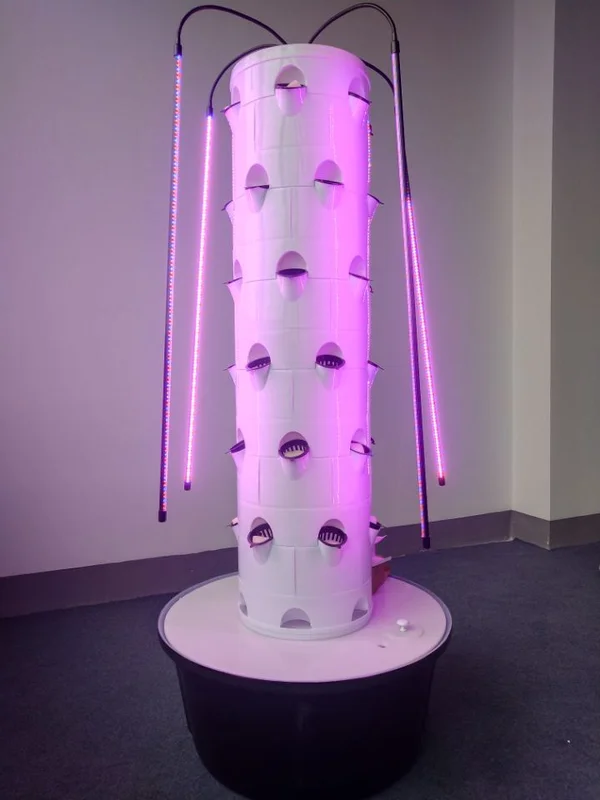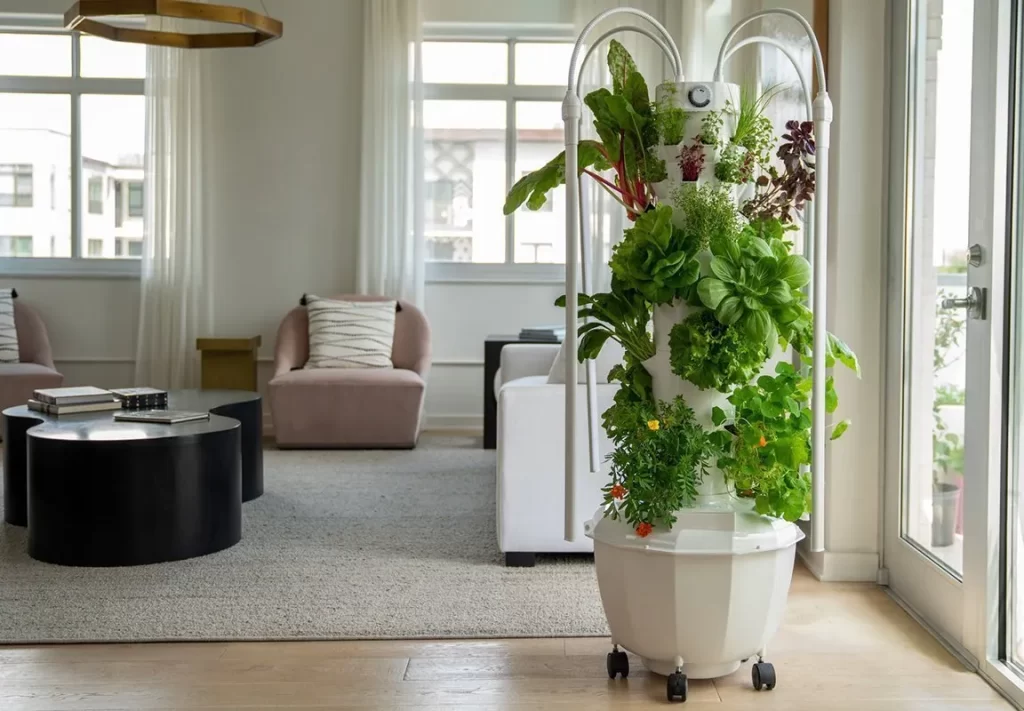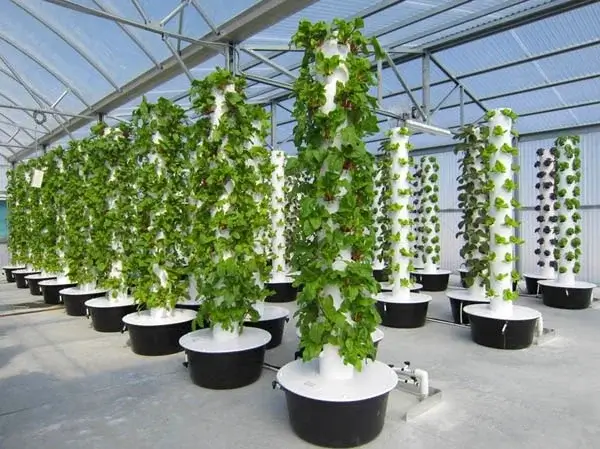How do Aeroponic Towers work?
What Is Aeroponic Farming?
Aeroponic farming is a cultivation technique that doesn’t rely on a traditional growing medium. Unlike systems such as hydroponics and aquaponics, which immerse plant roots in water, aeroponic plants are suspended in the air. Often known as vertical farming or tower gardening, aeroponics utilizes vertical structures known as aerofarms or aerogardens. Aeroponics is a highly efficient method for cultivating a wide variety of plants.
More than a decade ago, an ingenious American horticulturist named Tim Blank introduced the world to the first vertical aeroponic food growing system. This innovation wasn’t limited to professional growers; it was designed to be accessible to schools, restaurants, urban farms, and residential users alike.
With a heartfelt mission to provide food for all, the Tower Garden aeroponic system was initially conceived in the USA to empower sustainable urban farming, one farmer at a time!
This groundbreaking food cultivation technology not only conserves up to 95% of water but also saves an impressive 75% of space, all while increasing crop yields by up to 50%. A Tower Garden requires just 1 square meter of space and can nurture up to 44 plants concurrently!


Aeroponics vs Hydroponics
Understanding the Distinction While aeroponics is categorized under hydroponic gardening, a fundamental difference sets them apart: the presence of a growth medium. Both aeroponic and hydroponic methods involve soilless cultivation, but hydroponic systems immerse the plant’s root zone in a soil substitute. This substitute can be composed of materials such as vermiculite, mineral wool, coconut fiber (known as coco coir), peat moss, clay pellets, sand, perlite, or other similar substances. On the other hand, aeroponic systems elevate the plant’s roots above a water reservoir and employ misters to spray a nutrient-rich solution, promoting root development.


To initiate growth in aeroponics, seeds are placed within small pockets of foam inserted into miniature pots. These pots are positioned with one end exposed to light and the other end subjected to a nutrient mist. The foam also serves to support the plant’s stem and root structure as it develops.
Purchase your own Aeroponic Tower Garden Here
The Two Types of Aeroponic Systems come in two primary variants: low pressure and high pressure.
- Low Pressure: Low-pressure aeroponic systems use a coarser mist to provide plants with hydration. These setups are ideal for beginners, easy to establish at home, and relatively cost-effective to maintain. You can commonly find low-pressure systems at hydroponics stores.
- High Pressure: High-pressure aeroponic systems finely atomize the nutrient solution into an ultra-fine mist, efficiently delivering nutrients, water, and oxygen to the root systems. Commercial growers typically prefer high-pressure aeroponic systems, but they require substantial space and energy for operation, making them suitable for large-scale operations.
Benefits of Aeroponics
Who would have thought that bare roots could not only survive but also flourish? It turns out that eliminating the need for a traditional growing medium offers significant benefits to plant roots. Exposing them to extra oxygen leads to accelerated growth. Moreover, aeroponic systems are remarkably water-efficient, reducing irrigation needs by a staggering 95 percent compared to soil-based cultivation. Additionally, these systems promote nutrient recycling since the nutrients are held in the water.
Furthermore, aeroponics contributes to its eco-friendly reputation by enabling the production of large quantities of food in compact spaces. This approach is predominantly used in indoor vertical farms, which are becoming increasingly prevalent in urban areas, thus reducing the environmental footprint associated with transporting food from fields to tables. Moreover, because aeroponic systems are fully enclosed, there is no nutrient runoff that could harm nearby water sources. In place of harsh chemicals, alternative methods are employed to address pest and disease issues.
Growing with Aeroponics showcases the strength of Simplicity.


- Tower Garden produce significantly reduces the need for shipping and storage, resulting in a substantially reduced carbon footprint.
- It consumes as little as 2% of the water required for traditional gardening practices, promoting efficient water use.
- The vertical design occupies only 10% of the space typically needed for conventional produce growth.
- Tower Garden operates as a closed-system, recycling 100% of its nutrients and water, minimizing waste.
- Tower Garden Mineral Blends, rich in pH-balanced ionic minerals and plant nutrients, foster robust, resilient plants that can defend against insect pests and diseases, reducing the necessity for pesticides or herbicides.
Disadvantages of Aeroponics
Aeroponic systems demand a level of precision for effective operation. Maintaining the exact nutrient concentration in the water is crucial, as even a minor equipment malfunction can lead to a crop loss. For instance, if the misters fail to spray at regular intervals, perhaps due to a power outage, the dangling roots will quickly dehydrate. Furthermore, regular cleaning of the misters is essential to prevent them from becoming clogged by mineral deposits in the water.
From an environmental perspective, there is one notable drawback: aeroponic systems rely on electricity to pump water through the small misting devices. While they can be used in greenhouses with natural light, they are more commonly paired with energy-intensive grow lights. However, it’s possible to mitigate this drawback by harnessing solar power or other alternative energy sources.
What Equipment is Required?
Aeroponics Equipment Essentials In aeroponic systems, you’ll need two key components: an enclosure to maintain humidity and shield roots from light (usually a perforated plastic bin for each plant) and a separate tank to house the nutrient solution. Besides these basics, there are other factors to consider when designing an aeroponic system to meet your specific requirements.
Aeroponic systems can be either horizontal, resembling traditional beds, or vertical, which has gained popularity due to its space-saving benefits and efficient root spreading. Vertical systems also position misting devices at the top, using gravity for moisture distribution.
Another significant consideration is the type of aeroponic equipment: high-pressure or low-pressure systems.
Low-pressure systems use a basic fountain pump to spray water through misters, making them cost-effective and suitable for DIY projects. This method is sometimes called “soakaponics” as it provides a gentle spray similar to a small sprinkler, rather than true mist.
For genuine mist, where moisture hangs in the air, providing nutrients to the roots effectively, you’ll need higher water pressure than a standard pump can offer. Professional aeroponic systems use a pressurized water tank (capable of holding 60 to 90 psi) in combination with top-quality misters that emit the finest mist possible.
Many hydroponic suppliers offer a wide range of aeroponics equipment, including nutrients, pots, pumps, timers, tubing, and all the essentials for DIY systems, as well as fully automated turnkey aeroponic farming solutions.
What Can You Cultivate Using Aeroponics? In theory, virtually anything can be grown with aeroponics. However, in practice, aeroponic systems are mainly employed for the same purposes as hydroponic systems. These applications include growing leafy greens, culinary herbs, marijuana, strawberries, tomatoes, and cucumbers. Notably, aeroponics is well-suited for root crops, which are challenging in hydroponic systems but thrive in aeroponics due to ample root space and easy harvesting.
While it’s possible to cultivate various vegetable crops with aeroponics, they often come with more intricate nutrient requirements. Fruiting shrubs and trees, on the other hand, are not practical in aeroponic systems due to their size and complex growth patterns.


General FAQ’S
Which Plants Thrive in an Aeroponic Tower Garden?
Aeroponic tower gardens are versatile and can nurture various plants like leafy greens, herbs, strawberries, tomatoes, and peppers. Nevertheless, it’s crucial to select plants that align with the tower garden’s specific conditions, such as light and moisture needs.
How Much Does an Aeroponics System Cost?
DIY models can be made for less than $100, but good quality professional systems with automated nutrient monitoring and a backup power supply start in the four-figure range
How Much Space is Needed for an Aeroponic Tower Garden?
Aeroponic tower gardens are space-efficient and suitable for small gardens or indoor use. A tower garden with a few growing pods can easily fit on a balcony or patio, while larger systems may require more room.
Can I Use an Aeroponic Tower Garden Indoors?
Absolutely, aeroponic tower gardens can be used indoors, provided they have access to sufficient light and ventilation. Indoor tower gardens are perfect for cultivating herbs and other smaller plants, offering a convenient way to have fresh produce at home.
How Much Water Does an Aeroponic Tower Garden Consume?
Aeroponic tower gardens use less water compared to traditional gardening methods due to their closed system design. However, the water usage varies based on the system’s size, the number of plants, and the plant types being grown. Generally, a commercial tower garden growing leafy greens and herbs will use approximately 1-2 gallons of water per week. Smaller systems, like Gardyn’s 5-foot indoor towers, may only require a couple of gallons per week.
What Maintenance Does an Aeroponic Tower Garden Need?
To keep your aeroponic tower garden in top shape and your plants flourishing, regular maintenance is essential. This entails monitoring water nutrient levels, pH levels, and routine system cleaning. Furthermore, it’s crucial to regularly trim and harvest the plants to promote robust growth.
Watch Our Extensive Guide on How to Setup an Aeroponic Tower Garden

About the Author
Mr Stacky is the leader in Tower Garden Systems in Australia, specializing in commercial hydroponic farming, urban farming & residential vertical gardening.
Find out how he can help you achieve your food production goals. Contact Brian
